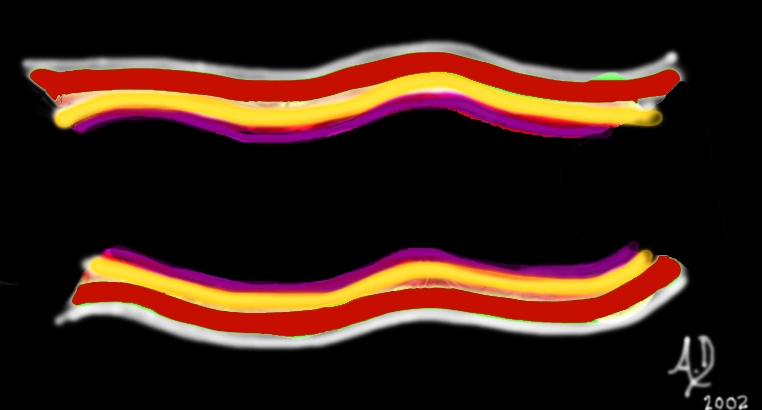Histology
Copyright 2008
At a histological level the upper one-third of the esophagus is striated muscle and the lower two thirds is smooth muscle. The smooth muscle contains an inner circular layer and an outer longitudinal layers.
Mucosa, a submucosa, a muscularis and an adventitia. The mucosa is made up of epithelium, the lamina propria and a muscularis mucosae.

| Esophagus – Histology |
| 32337 tube colon small bowel lung bronchus bronchi esophagus stomach large bowel bile duct ureter tube pinciples mucosa submucosa muscularis adventitia serosa Courtesy Ashley DAvidoff MD Davidoff art mucosa submucosa muscularis adventitia serosa histology |
Principles

Basic Strcture of Tubular Systems |
| 32347 tube colon small bowel lung bronchus bronchi esophagus stomach large bowel bile duct ureter tube principles Courtesy Ashley DAvidoff MD Davidoff art mucosa submucosa muscularis adventitia serosa histology |

Stratified Squamous Epithelium |
| 12246.800 esophagus normal epithelium stratifed squamous epithelium histology Courtesy Barbara Banner MD |
The esophagus is lined by stratified squamous epithelium, which is a continuation from the pharyngeal lining. The surface cells of this epithelium are flattened and contain a few keratohyalin granules, but are not cornified. An abrupt transition takes place between the stratified squamous epithelium of the esophagus and the columnar epithelium of the stomach along an irregular zigzag line, also known as the “ZZ” line.
The submucosa is quite dense and contains both elastic and collagen fibers. A moderate number of lymphocytes is scattered through both the lamina propria and the submucosa.
The muscular coat consists of an inner layer, called the circular layer, and an outer longitudinal layer. A thin layer of connective tissue, in which is embedded the myenteric plexus of Auerbach, is spread between the two muscular layers. The submucosa contains Meissner’s plexus and also some blood vessels.
The superior third consists of voluntary striated the distal third consists of smooth muscle and the middle third has both types of muscle.
The adventitia consists of loose connective tissue, connecting the esophagus to its surrounding structure. No discrete capsule is present. his is quite unusual.
Two types of glands can be recognized in the esophagus. One of them, the esophageal glands proper, or deep glands, are irregularly distributed throughout the entire length of the tube. They are small, compound racemose glands of the mucous type. Their ducts penetrate the muscularis mucosae, and their branched tubules lie in the submucosa. The glands of the other type are known as the cardiac glands, or superficial glands because they closely resemble or are identical with the cardiac glands of the stomach. They are found at both ends of the esophagus, i.e for a few centimeters below the level of the cricopharyngeus muscle and also just above the cardia. They differ from the esophageal glands proper in that their ducts do not penetrate from the muscularis mucosae and their branched and coiled tubules are located in the lamina propria, not in the submucosa.
